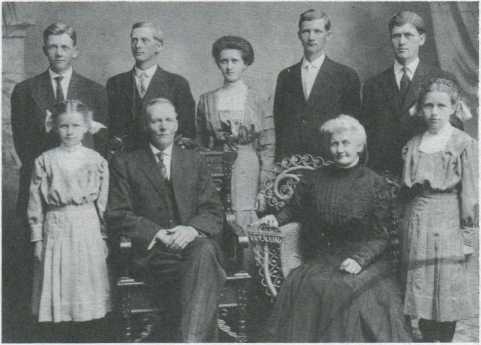|
the local hospital; and Martha (Mrs. L.M. Rikansrud) of Lansing.
Katherina also recalled how the Indians used to come around every year when she was a girl. They would camp on Bear Creek and on the Upper Iowa River in the Highlandville vicinity. They would come and beg for pork, flour and corn meal. “They were especially fond of pork," she recalled. “I always kept some of those foodstuffs on hand to give them. I was just a little afraid of displeasing them."

Peter and Kathrina Bidne family Front row, left to right: Martha, Peter, Kathrine and Olga. Back row, left to right: Knut,
Sander, Sylvia, Joseph and Clarence.
She recalled with a slight shudder the nightly howling of wolves in the hills of Winneshiek Co. “I remember what a bad night Lena Bidne had with wolves. A pack came right up within a little distance of Lena's log cabin home. Sitting back on their haunches out there in the moonlight, they set up a howl that set Lena's blood on fire. She was alone with her two little children at the time, and it was all she could do to keep the family dog from leaping out the window to get with the wild beasts."
Although, she stoned dozens of rattlesnakes to death when she was a girl, Katherina never was bit by one. Their livestock, also fortunately, escaped the venomous bite of the rattlesnakes that were so common in that region in the early days.
In those days there was no white sugar. Everybody used brown sugar and sorghum for cooking and table use. When white sugar first became available, it was such a luxury it was called “coffee sugar" and was used very sparingly.
“We didn’t have so many frills in food in those days," Katherine explained. “There was little fruit. Flour was dark and coarse, more like livestock feed. We'd sift it out at home and make graham bread. We ate lots of flatbrod. We baked in outdoor ovens in the summertime and on top of the kitchen stove in the winter. There were no ovens in our stoves in those days.”
Katherina recalled making dry sausage which she says was delicious. After the meat was ground and seasoned, it was stuffed into casings and tied in rings. These were looped over a pole in a smoke shed and permitted to dry out.
At Christmas and Easter early settlers in this country always made their own beer. This was traditional at these seasons of the year. In the spring the farmers made another batch of beer to serve the harvest hands.
Katherina Bidne died in 1950 at the age of 89. Bigler, Ernest and Elizabeth (Schroeder)
(Lorraine Houck)
Ernest Bigler was born in Clayton Co. 25 apr 1874. Fie was the son of Gottieb and Mary Bigler. Gottieb was born in Odelboden, Switzerland 30 Mar 1843 and died 4 Sep 1913. Mary was born in Germany in 1838 and died in 1910.
Ernest married Elizabeth Schroeder. They moved from Clayton Co. to Winneshiek Co. and settled in Pleasant Twp. in 1912. The farm is located 3 farms south of the Sattre Store. They had 8 children: Elmer, Elsie, Lester, Harvey, Roy, George, Harry and Walter.
Ernest was a very strong man who was always willing to help anyone in need. Honesty was on the top of his list of importance.
He owned a beautiful black purebred Percheron stallion that weighed two thousand four hundred pounds. Ernest would travel in a buggy pulled by a gray mare as the stallion walked along side to be taken to the local farms for stud service. There were times when it was too far to return home in one day so he would spend the night with the farm family. He is known to have had as many as thirty-seven horses on his farm.
He was very proud of his very large garden and for a few years provided potatoes for Luther College. It was the duty of the grandchildren in the spring of the years to gather in the basement and “de-sprout" potatoes for planting. Many jars of fruits, vegetables and grape juice lined the basement shelves.
The grandchildren helped gather wild grapes which were used to make wine; this wine was given to the Lutheran Church at Locust to be used for communion wine. Pastor Carl Losen was pastor at that time. The tame grapes were canned to be used for delicious tasting grape juice during the winter months.
Sugar cane was also raised on the Bigler farm. In the fall it was taken to Charley Steinbach in Ferris Mills to be put through a horse- powered tread-machine-press to extract the juice. When this mill closed the sugar cane was taken to Clermont, IA.
Ernest had one of the first Kohler Plants in the area that provided electricity for the farm. People in the area would bring their batteries to him to be recharged.
A neighbor, Halvor Forde, would walk 2 miles to the Bigler farm. He came to patch grain sacks and overalls for the family.
Ernest liked to entertain his family and friends by playing the mouth organ and yodeling.
B-36
Complete OCR transcription.
See the associated scan to compare with the published information. | 
